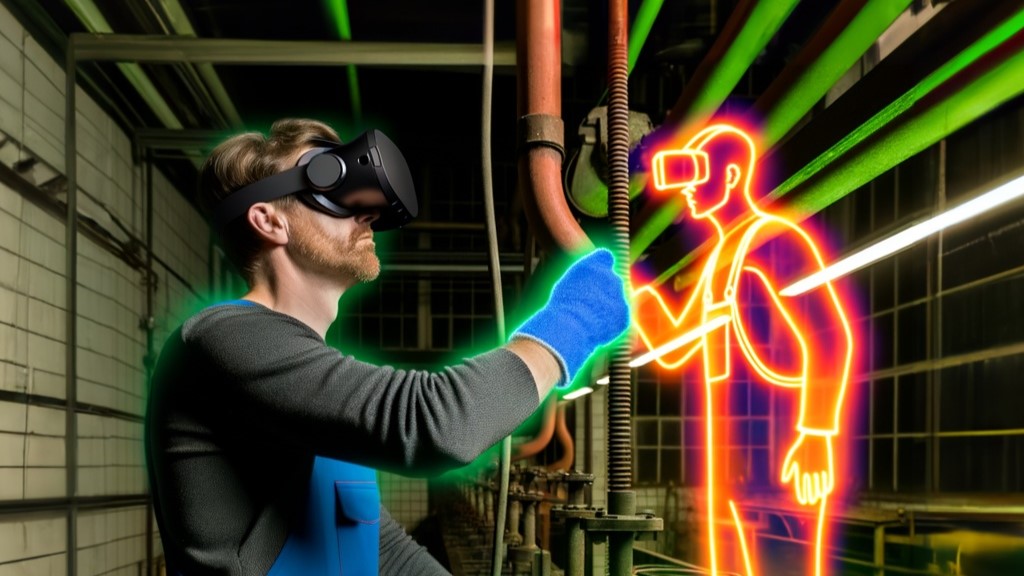Immersive learning: VR reboots online training for staff

|
Getting your Trinity Audio player ready...
|
As companies set their training budgets for 2024, there are good reasons to predict that spending on immersive learning solutions delivered through VR will increase. Improvements in VR headsets, including the addition of mixed-reality experiences, have enriched online training options for staff. But there’s another big factor as to why organizations are ramping up on VR-based training – detailed performance analytics. “VR’s superpower is being able to track movement through time and space,” Tom Symonds – CEO of Immerse – told TechHQ.
Online VR-based training courses for staff have the capacity to measure not just whether trainees have passed or failed a task, but can determine how well they performed. For example, when learning a new manufacturing process, did the operator move too fast or too slow, and how consistent were their actions?
VR training superpower
In sport, modern VR systems can differentiate between players of different skill levels – for example, distinguishing between novice, academy, and professional soccer players – in this case, using motion tracking sensors attached to shin pads and training shoes. And these analysis capabilities cross over into other areas.
“Life sciences companies have a very specific understanding of the prospects,” said Symonds, noting a sector that’s paying particularly close attention to the multiple benefits of VR when considering online training options for staff.
Thanks to the immersive learning experience of VR-based training, it’s possible for firms to enable their staff to walk around new factories and get to grips with processes ahead of facilities being opened. It means that companies growing fast can hit the ground running and don’t have to wait as long to achieve full production capabilities.
Not only do skills learned in VR translate remarkably well into the workplace, those skills can be coached with precision thanks to the detailed performance analytics only available with body tracking. “We’re just at the beginning of what can be done with that data capture,” adds Symonds.

Work shadowing: skills can be coached with precision using VR-based training tools.
With the ability to gather many data points per second, it’s easy to imagine how best practice could be recorded and then ghosted in VR for trainees to follow.
One of the big takeaways looking at today’s immersive learning opportunities is how VR takes online training courses for staff to a new level. More than just generating crude pass/fail results, which offer little insight for managers and industry coaches, learning experiences can become much more performance-based.
That’s not to say that barriers to more widespread adoption of VR-based online training for staff don’t remain. A common issue is that VR has to be seen to be believed, but Symonds sees this as more of a speedbump than a long-term problem. “It rarely takes more than a couple of minutes before they get it,” he said, commenting on how quickly people start to champion VR-based training once they put a headset on.
READ NEXT

How to get started with 3D gen AI
It also helps that tech giants such as Meta and Apple are investing millions of dollars in developing new spatial computing hardware, such as the Quest 3 and Vision Pro – spreading the word on the features and benefits of VR through global advertising campaigns.
Immerse reports various metrics for why it makes sense for companies to consider VR options when thinking about online training opportunities for staff. Lessons learned in VR are memorable and, as mentioned, translate well into the workplace. The firm has seen a 76% accident risk reduction for clients using VR-based training content on its platform.
Naturally, there are also cost savings for remote learning tools. Staff can upskill without leaving the home or office. And the richness of the training experience means that courses are often shorter than classroom equivalents, with candidates ready to operate real-world equipment in record time.
Symonds makes the point that training solutions have to be able to scale, and modern platforms enable training content to be streamed to multiple users. Immerse’s solution also provides a marketplace connecting content makers with customers wanting VR training material.
VR training is transforming medical education! A @UCLA-backed study reveals a remarkable 44% reduction in procedure time. 👩⚕️
Results:
Higher global assessment scores (17.5 vs. 7.5)
More correct steps (63% vs. 25%)
Superior knowledge improvement (50% vs. 11%)📹 Jeremy Dalton pic.twitter.com/gReRZ78igf
— Varun Kumar Siddaraju (@varunsiddaraju) November 13, 2023
Its content library contains more than a hundred different VR training applications across multiple industry sectors. For companies wanting to get started, Symonds recommends starting with some common training types, such as health and safety topics. And Immerse offers ‘VR in a box’ – which includes headsets, five marketplace apps of your choice, access to the streaming platform for content distribution and tracking, and comes with a mobile device management solution pre-installed.
Looking at the topics covered, it’s clear that the ability to fail safely is another appealing feature of VR-based training. Hazard awareness and how to work safely at heights are certainly skills that are worth brushing up on, and there are multiple modules designed for workers in the mining industry.
Online training options for staff are broad. Bodyswaps – one of Immerse’s content partners – uses VR training for soft skills development. First, users practice their skills, in their own words, using their own voice and body language. Then – thanks to the motion-tracking capabilities of VR, they can swap bodies and watch back from another perspective, which provides an impactful learning experience.
Earlier this year, at Meta Connect – which Symonds attended – Mark Zuckerberg spoke about how generative AI would improve the capabilities of so-called non-player characters (NPCs). And you can picture how NPCs, trained using a company’s standard operating procedures, could add to enterprise VR training scenarios – helping to direct employees on specific activities and tasks, and acting as virtual training assistants.
However, companies and their employees don’t need to wait for the future to benefit from VR training. We’ve listed some of the online training options for staff below to give a flavor of how immersive learning in VR has grown.
List of VR training providers –
| VR training platform | Course examples |
|---|---|
| Bodyswaps | Soft skills for corporate, healthcare, education environments |
| Boundless | Product training, health and safety, hazard and risk avoidance simulations |
| Cassette | Soft skills, medical devices, patient treatment |
| Future Visual | Aviation ground operations |
| Immerse | Manufacturing, life sciences, soft skills, health and safety, hazard and risk avoidance simulations |
| Jenson8 | Behavioural change in the workplace |
| Luminous Group | Process based training, virtual onboarding |
| MOONHUB | Dementia care |
| Motive.io | Soft skills, simulation and procedural training |
| NMY | Mixed reality experiences and digital twin creation |
| Onix Systems | Maritime training, construction, retail, healthcare, energy |
| Osso VR | Surgical training and assessment |
| Pixaera | Industrial workplace training |
| STRIVR | Operational efficiency, health and safety, customer service, soft skills |
| Virtual Speech | Public speaking, leadership, sales |
| Warp VR | Transportation, manufacturing, oil and gas, energy, retail and hospitality, healthcare, education, construction and offshore |








